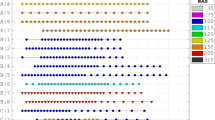Abstract
Objective
We have developed a method to automatically set regions of interest (ROI) (automated ROI) on cerebral blood flow single-photon emission computed tomography (SPECT) images with morphological information specific to the subjects. The objective was to set ROIs automatically without losing individual morphological information in the SPECT images and then evaluate its validity and clinical applicability.
Methods
We constructed the volume of interest (VOI) template on the standardized brain generated by NEUROSTAT to determine the regions for ROIs to be set. Assuming patients with cerebral vascular disease, the VOI template was constructed so that the ROIs were drawn for the major vascular regions and 17 regions in total within the hemisphere, basal ganglia, thalamus, cerebellar cortex, cerebellar vermis, and pons. By comparing the major vascular occlusion models, the accuracy of region setting by the VOI template was evaluated for validation. Using the anatomical standardization of NEUROSTAT and inverse transformation, the automated ROI transformed the VOI template into the individual brain shape and then the VOI template was extracted from each slice to determine ROIs. An evaluation was made by visually investigating the effect of a different image quality and cerebral blood flow tracers using brain phantom and clinical data. The regional cerebral blood flow (rCBF), determined by the manual setting method of ROI (manual ROI) and automated ROI, was compared. We also compared automated ROI with other morphological images using clinical data.
Results
The VOI templates accurately showed the region with the reduced blood flow in the major vascular occlusion model, which validated the proper ROI setting. The brain phantom study demonstrated that ROI settings were least influenced by matrix size, image quality, and image rotation. The observation with the clinical data also indicated that the variation in cerebral blood flow tracers little affected the ROI settings. The comparison with manual ROI revealed a strong correlation between the two ROI settings, and the mean values within both ROIs were similar. The comparative evaluation with morphological images, obtained by magnetic resonance imaging (MRI), verified the accurate setting of ROI.
Conclusions
The automated ROI achieved successful automatic ROI settings without distorting individual SPECT images. The automated ROI is not affected by the differences in the image quality or the cerebral blood flow tracers, which suggests versatile applicability. Thus, the use of automated ROI may eliminate the interoperator and interfacility variability in ROI setting and improve objectivity and reproducibility. It also allows comparative evaluation at the same transverse level with images acquired with other modalities such as MRI and is expected to enhance the clinical diagnosis.
Similar content being viewed by others
References
Kuhl DE, Barrio JR, Huang SC, Selin C, Ackermann RF, Lear JL, et al. Quantifying local cerebral blood flow by N-isopropyl-p-[123I] iodoamphetamine (IMP) tomography. J Nucl Med 1982;23:196–203.
Matsuda H, Seki H, Ishida H, Sumiya H, Tsuji S, Hisada K, et al. Regional cerebral blood flow measurement using N-isopropyl-p-[123I] iodoamphetamine and rotating gamma camera emission computed tomography. Kaku Igaku 1985;22:9–18.
Iida H, Itoh H, Nakazawa M, Hatazawa J, Nishimura H, Onishi Y, et al. Quantitative mapping of regional cerebral blood flow using Iodine-123-IMP and SPECT. J Nucl Med 1994;35:2019–2030.
Ito H, Ishii K, Kinoshita T, Koyama M, Kawashima R, Ono S, et al. Normal CBF values by the ARG method using IMP SPECT: comparison with a conventional microsphere model method. Kaku Igaku 1996;33:175–178.
Pelizzari CA, Chen GTY, Spelbring DR, Weichselbaum RR, Chen CT. Accurate three-dimensional registration of CT, PET, and/or MR images of the brain. J Comput Assist Tomogr 1989;13:20–26.
Greitzs T, Bohm C, Holte S, Erikson L. A computerized brain atlas: construction, anatomical content, and some applications. J Comput Assist Tomogr 1991;15:26–38.
Evans AC, Beil C, Marrett S, Tompson CJ, Hakim A. Anatomical-functional correlation using an adjustable MRI-based regions of interest atlas with positron emission tomography. J Cereb Blood Flow Metab 1988;8:513–530.
Evans AC, Dai W, Collins L, Neelin P, Marrett S. Warping of a computerized 3-D atlas to match brain image volumes for quantitative neuroanatomical and functional analysis. SPIE 1991;1445:236–246.
Takeuchi R, Yonekura Y, Matsuda H, Konishi J. Usefulness of a three-dimensional stereotaxic ROI template on anatomically standardized 99mTc-ECD SPET. Eur J Nucl Med Mol Imaging 2002;29:331–341.
Takeuchi R, Yonekura Y, Katayama S, Takeda N, Fujita K, Konishi J. Fully automated quantification of regional cerebral blood flow with three-dimensional stereotaxic region of interest template: validation using magnetic resonance imaging. Neurol Med Chir (Tokyo) 2003;43:153–162.
Minoshima S, Berger KL, Lee KS, Mintun MA. An automated method for rotational correction and centering of three-dimensional functional brain images. J Nucl Med 1992;33:1579–1585.
Minoshima S, Koeppe RA, Frey KA, Kuhl DE. Anatomic standardization: linear scaling and non linear warping of functional brain images. J Nucl Med 1994;35:1528–1537.
Laurent T, Thierry M, Julien B, Henri D. Arterial territories of the human brain: cerebral hemispheres. Neurology 1998;50:1699–1708.
Talairach J, Tournoux P. Co-planar stereotaxic atlas of the human brain. New York: Thieme; 1988.
Maes F, Collignon A, Vandermeulen D, Marchal G, Suetens P. Multimodality image registration by maximization of mutual information. IEEE Trans Med Imaging 1997;16:187–98.
Zhu YM, Cochoff SM. Influence of implementation parameters on registration of MR and SPECT brain images by maximization of mutual information. J Nucl Med 2002;43:160–166.
Thurfjell L, Lau YH, Andersson JL, Hutton BF. Improved efficiency for MRI-SPET registration based on mutual information. Eur J Nucl Med 2000;27:847–856.
Ichihara T, Ogawa K, Motomura N, Kubo A, Hashimoto S. Compton scatter compensation using the triple-energy window method for single- and dual-isotope SPECT. J Nucl Med 1993;34:2216–2221.
Chang LT. A method for attenuation correction in radionuclide computed tomography. IEEE Trans Nucl Sci 1978;25:638–643.
Author information
Authors and Affiliations
Corresponding author
Rights and permissions
About this article
Cite this article
Ogura, T., Hida, K., Masuzuka, T. et al. An automated ROI setting method using NEUROSTAT on cerebral blood flow SPECT images. Ann Nucl Med 23, 33–41 (2009). https://doi.org/10.1007/s12149-008-0203-7
Received:
Accepted:
Published:
Issue Date:
DOI: https://doi.org/10.1007/s12149-008-0203-7




